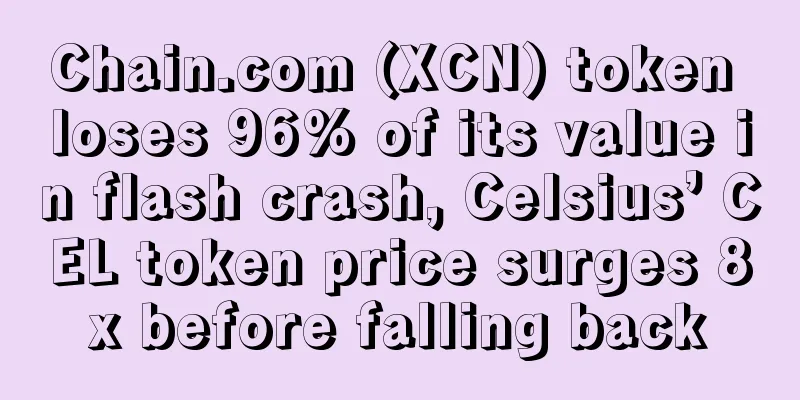Chain.com (XCN) token loses 96% of its value in flash crash, Celsius’ CEL token price surges 8x before falling back

|
On Tuesday, the token of cloud blockchain infrastructure provider Chain.com (XCN) suddenly lost more than 90% of its value before recovering most of the losses later in the day. In a post-mortem analysis published by Chain.com, the company said that market maker and API errors caused XCN to fall sharply. Further downward pressure was caused by low liquidity and margin calls. XCN token prices quickly recovered after developers determined that a technical issue, rather than a security vulnerability, triggered the massive sell-off. According to Chain.com CEO Deepak.eth , a large margin call appears to have exacerbated the flash crash, with up to 500 million XCN ($42.24 million at the time of publication) worth of tokens purchased via leverage being liquidated in a short period of time. The price of a token is not always proportionally related to changes in supply and demand. Contrary to popular belief, a single large trade or a series of large buy/sell orders in a short period of time can have a disproportionate impact on the price of a token, especially when there is little liquidity. For example, as crypto enthusiast dev.eth first pointed out last month, the price of the token for crypto project Cope fell 77% after developers said they needed to sell tokens to “get developers through this tough time.” However, due to a lack of liquidity, the developers only had to sell 10% of the circulating COPE tokens to cause the massive drop. Meanwhile, the CEL token of troubled crypto lending platform Celsius jumped eightfold, from 30 cents to an intraday high of $2.57, according to FTX data. But within an hour of the surge, CEL's price fell back and was trading around 54 cents at press time, with a market cap of around $125 million. That’s still up from 35 cents before the recent crash, when Celsius halted withdrawals on Sunday, citing “extreme market conditions.” In response to the news, Celsius’ CEL token plunged 48% from 35 cents to 18 cents late Sunday. The latest price surge appears to have been driven by large spot buyers on crypto exchange FTX, according to data from the exchange. One trader who spoke to CoinDesk said the price action suggests a short squeeze in the market because shorting Celsius tokens has become an “overcrowded trade.” A “short” position is one in which traders bet that a token’s price will fall. A short squeeze occurs when a token’s price rises sharply, prompting traders who were short it — often with borrowed money or tokens — to buy back or “cover” their positions to avoid even bigger losses. Questions surrounding Celsius’ financial situation have been making waves in the cryptocurrency market. On Tuesday morning, Celsius appeared to have repaid $28 million of its outstanding loan with Maker, a decentralized finance protocol for lending the stablecoin DAI . The company also appears to have $250 million in Bitcoin collateral outstanding. |
<<: Maybe this bear market isn’t such a bad thing for cryptocurrencies?
Recommend
CCEDK launches new encrypted digital currency OBTIS, where holders can share transaction profits
Translation: Kentucky Major Crypto Coins Exchange...
Does a woman with high cheekbones mean she will be unlucky in marriage? Is it not advisable to marry a woman with high cheekbones?
If a woman's cheekbones are in a good positio...
What kind of people have high expenses?
What kind of people have high expenses? Large nos...
CriptoNoticias interviews Ethereum OTC platform localethereum
Earlier this year, localethereum was interviewed ...
Analysis of moles on women's faces Detailed analysis of moles on women's faces - eyes
Analysis of moles on women's faces, detailed ...
Digital Asset announces acquisition of fourth blockchain startup Elevence, including its assets and senior personnel
Digital Asset Holdings Inc. has announced that it...
What does a woman’s strong sexual desire look like in terms of her personality and features?
Women play important roles in social life, such a...
What does it mean when a man has a mole on his testicles? What is the fate of a man with a mole on his testicles?
Moles in private parts are often ignored by us, b...
Will ETC take over ETHPOW? The current status of the 38 projects on the old public chain ETC
As the ETH POS merger date approaches, the discus...
Analysis: What should you do if you have a bad mole? Can it be resolved?
Mole physiognomy is a traditional Chinese physiog...
What kind of facial features will affect whether a marriage can last forever?
Physiognomy has been passed down from ancient tim...
Physiognomy teaches you how to choose a suitable business partner
It is easy to find someone of the opposite sex yo...
The biggest risk factor for many projects in 2021: unavoidable SEC regulation
On December 29, the long-rumored news in the mark...
What facial features of a woman indicate that she will not have children
As the saying goes, the three worst types of unfi...
How to understand a person's personality through forehead physiognomy
People with round foreheads If a person has a rel...









